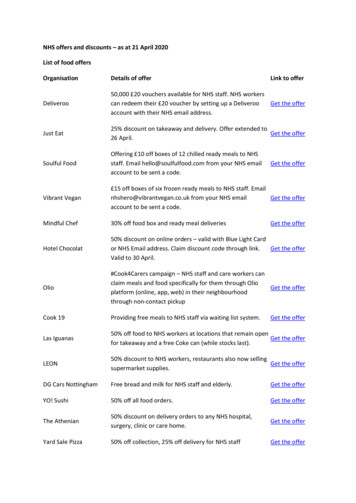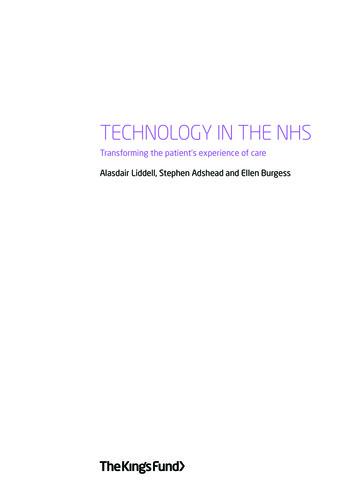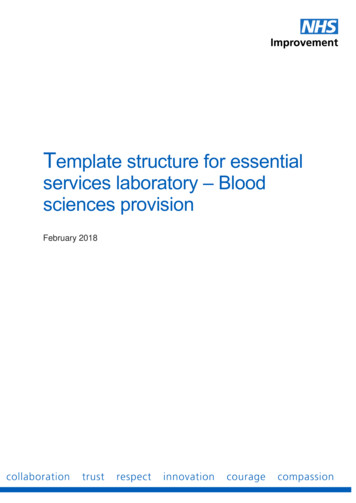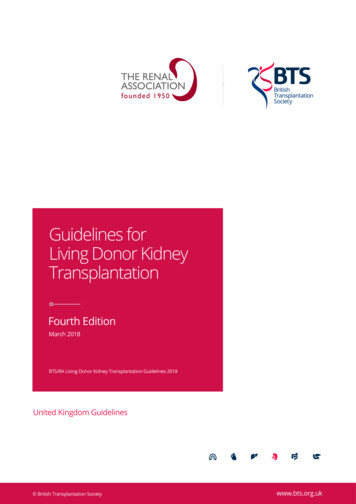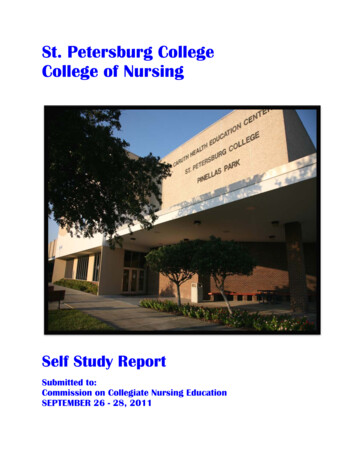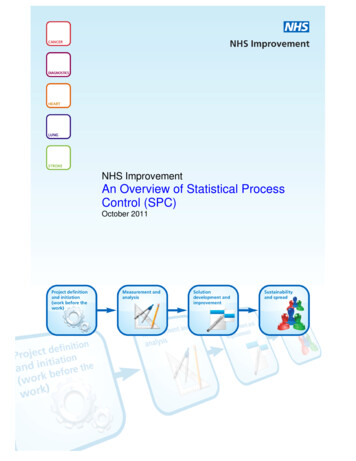
Transcription
NHS ImprovementAn Overview of Statistical ProcessControl (SPC)October 2011
Statistical Process Control Charts (X, Moving R Charts)What is Statistical Process Control (SPC)?We all know that measurement is integral to the improvement methodology in healthcarebut how do we know whether or not we have actually made a difference and if the carebeing delivered is getting better, staying the same or getting worse each year? What wedo not always take into account is the variation in the way that services are delivered –by individual departments, people and even different types of equipment. All of thesedifferences in the way things are done lead to differences in the way services aredelivered.The main aims of using Statistical Process Control (SPC) charts is to understand what is‘different’ and what is the ‘norm’. By using these charts, we can then understand wherethe focus of work needs to be concentrated in order to make a difference. We can alsouse SPC charts to determine if an improvement is actually improving a process and alsouse them to ‘predict’ statistically whether a process is ‘capable’ of meeting a target. SPCcharts are therefore used: As way of demonstrating and thinking about variationAs simple tool for analysing data – measurement for improvementAs a tool to help make better decisions - easy and sustainable to useThe way in which data within healthcare is traditionally analysed leads to confusion andinaccuracy. The simple fact that important operational decisions are often made fromdata where there is limited understanding of the ‘process’ and its ‘variation’ is oftenworrying. If individuals do not understand variation, they often look at data (as in thechart below) and: They see trends where there are no trendsThey try to explain natural variation as special eventsThey blame and give credit to people for things over which they have no controlThey can’t understand past performanceThey can’t make predictions or plan for the futureTheir ability to make improvements is limitedNHS Improvement2August 2011
ABSENTEEISM BY nuaryVariationThere are two types of variation found within SPC charts:Natural (common cause) variationIs inherent in the design of the processResults in a stable – IN CONTROL – process because the variation is predictableIs due to random or chance causes of variation 80706050403020100F MA M J J A S O N D J F MA M J J A S O N DNHS Improvement3August 2011
Special cause variation Is due to irregular or unnatural causes that are not inherent in a process extrinsicResults in an unstable – OUT OF CONTROL – process because variation is notpredictableIs due to non-random or assignable causes of variation (i.e. a signal that theprocess has ‘changed’)9080706050403020100F M A M J J A S O N D J F M A M J J A S O N DControl Charts vs. Run ChartsRun charts have traditionally been used in service improvement to measure changes ina process over time. There is however marked differences between run charts and SPCcharts – in addition to the mean or average, control charts have 2 extra lines that arecalculated using modified statistics and these determine the variation range. These linesare commonly referred to as the Upper Control Limit (UCL) – the upper line, and LowerControl Limit (LCL) – the lower line. SPC charts require an absolute minimum of 10 datapoints in order to create a valid chart, although there is increased reliability when using20 or more data points. Data should also be plotted chronologically in date or processorder and ideally represent an individual as opposed an aggregate value.In summary, control charts: Are more sensitive than run charts – a run chart cannot detect special causes dueto point to point variation or use rules for detecting special causesHave the added feature of control limits which estimate natural variationDefine process capabilityAllow us to more accurately predict process behaviorNHS Improvement4August 2011
What can SPC do for you?SPC charts have multiple uses but in summary can be used: To identify if a process is sustainable - i.e. are your improvements sustaining overtimeTo identify when an implemented improvement has changed a process - i.e. it hasnot just occurred by chanceTo understand that variation is normal and to help reduce itTo generally understand processes - helping make better predictions and thusimprove decision makingTo recognise abnormalities within processesTo prove or disprove assumptions and (mis) conceptions about servicesTo drive improvement – used to test the stability of a process prior to redesignwork, such as Demand and CapacityFurther practical applications of SPC charts include the ability to calculate a‘recommended capacity’ based on demand by using the charts to plot daily demand overtime.What will SPC not do for you?SPC charts are very useful, but they will not: Solve your process issues – you will need background intelligence in order tounderstand the process for potential redesignProvide all the answers – SPC analysis is a tool to compliment all othermethodologies i.e. process mapping and discovery interviewsValidate data – SPC is only as valid as the data usedHow do I create an SPC chart?SPC charts can be created manually but this tends to be a rather laborious exercise.There is a host of software available commercially than can create these and many othertypes of SPC charts for you from the data you enter. You can however use the NHSImprovement System to create both SPC and Capacity charts subject to your accessagreement to the system.If you are interested in the calculations used to create an SPC chart (which can be donein excel for example), they are as follows: Use individual values to calculate the averageNHS Improvement5August 2011
Calculate the difference between 2 consecutive values for all of the values as themoving range mR – these values are always i.e. the difference between 5 and 6 1 and the difference between 7 and 0 7 Calculate the average mR Calculate one Sigma Average mR/d2* Calculate the Upper Control Limit (UCL) Average (3 x Sigma) Calculate the Lower Control Limit (LCL) Average – (3 x Sigma)*The bias correction factor, d2 is a constant for given subgroups of size n (n 2, d2 1.128)What do I do next?Once you have a chart, you will need to understand what it means in order to determineyour next course of action. Initially you will be looking to see if a chart contains specialcause variation or natural variation – is the process in control or out of control. You needto remember that a process containing special cause variation is unpredictable and thedata should not be used to reliably calculate a processes capability.Is the initial process stable?YesNoType of variation Natural (common) Special naturalRight ChoiceChange theprocessWrong ChoiceTreat normalvariation as aspecial cause(tampering)IncreasedvariationConsequences ofmaking the wrongchoiceNHS Improvement6Investigate theorigin of thespecial cause(s)Change theprocessWastedresourcesAugust 2011
Determining the type of variation contained within a process is crucial at this stage (seechart above) as your intervention could lead to increased variation or wasted resources ifyou take the wrong course of action. This is why it is sometimes better to use SPC todetermine the type of variation before any service improvement work i.e. demand andcapacity.You should then develop improvement strategies - improvement strategies aredetermined by the sources of variation. Special cause variation – investigate and find out why it exists and what eachspecial cause data point may mean- remember that not every special cause is a negative factor as by redesigningthe process, you are inadvertently introducing special cause variation Natural (common cause) variation – change the process if you want to improve- Reduce the amount of variation by redesigning the processThe control limits will give you a reliable indication in terms of the overall variation withinthe process. For example, the chart below represents a call to needle process whereindividual patient call to needle times have been plotted chronologically over time. Whilethe average time is 50.64 minutes, the variation is between 0 and 106.93 minutes. Thiswould indicate that any patient entering this process could expect to wait between 0 and107 minutes to receive thrombolysis treatment from their point of call. Special causevariation points have also been flagged which would require further investigation in orderto understand this process.NHS Improvement7August 2011
There are different types of special cause variation points found within SPC charts –some software automatically highlights these points for you, such as the NHSImprovement System, but you can find more details about SPC by using the links tofurther resources within this section.You can then continue to use SPC charts to see if there has been an improvement in theprocess. Usually as this occurs over time, you will see the overall variation reducing andthe process capability increasing. SPC charts should not be considered as a ‘one-off’methodology but used continually to monitor a processes performance and to measurefor improvementProcess CapabilitySPC charts can also enable you to see if a particular process can meet a specific target.The calculation used will determine the process capability. Most software currentlyavailable to generate SPC charts will not calculate the process capability so this willhave to be done manually. However, Rapport will calculate this for you.The calculation used to determine process capability is:Capability Target - Average3 * standard deviationA value of 1 means the process is 100% capable of achieving the target. A negativefigure means more than 50% of patients will not meet a given target.The procedure for calculating process capability is therefore: Test for stability by plotting a control chart first If unstable, gain control by identifying and controlling the main factors that affectthe situation Only if it is stable, calculate a process capability to determine if it is capable ofmeeting the targetLinks to further resourcesFor information on improvement knowledge and skills and on measurement forimprovement, see the Improvement Leaders Guides produced by the NHS Institute forInnovation and provementLeadersGuidesBoxSet.htm.NHS Improvement8August 2011
The series of guides covers General improvement skills, process and systems thinkingand personal and organisational development in 13 booklets.All of the service improvement tools and techniques training materials can be accessedby going to:The Directory of Improvement Resources on the NHS Improvement System.NHS Improvement9August 2011
NHS Improvement3rd Floor St Johns HouseEast StreetLeicester LE1 6NBTelephone 0116 222 5253Email: Support@improvement.nhs.uk
The main aims of using Statistical Process Control (SPC) charts is to understand what is ‘different’ and what is the ‘norm’. By using these charts, we can then understand where the focus of work needs to b




